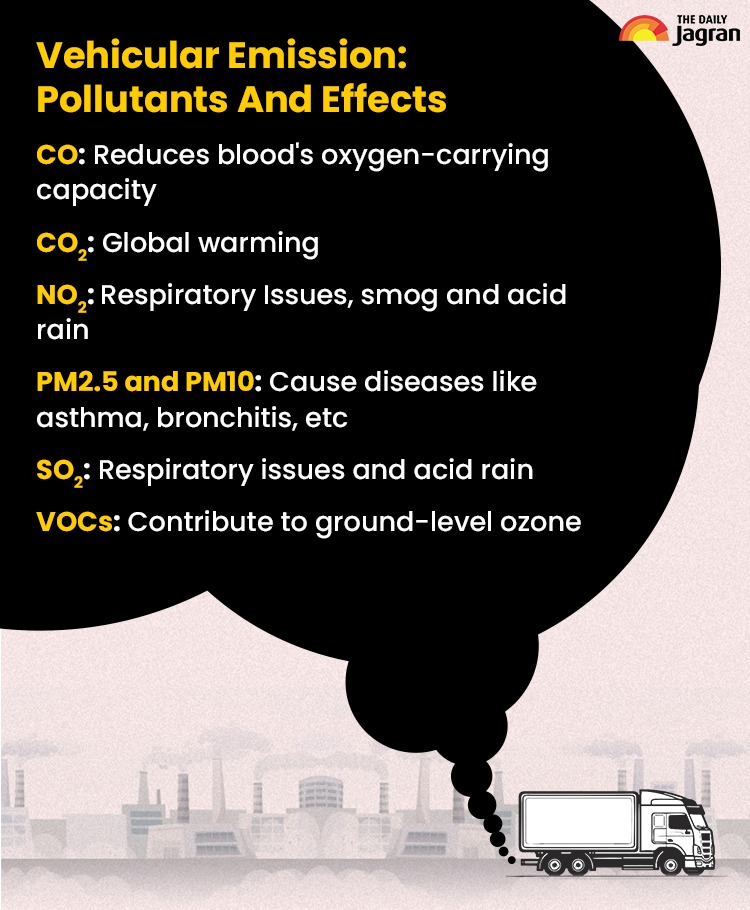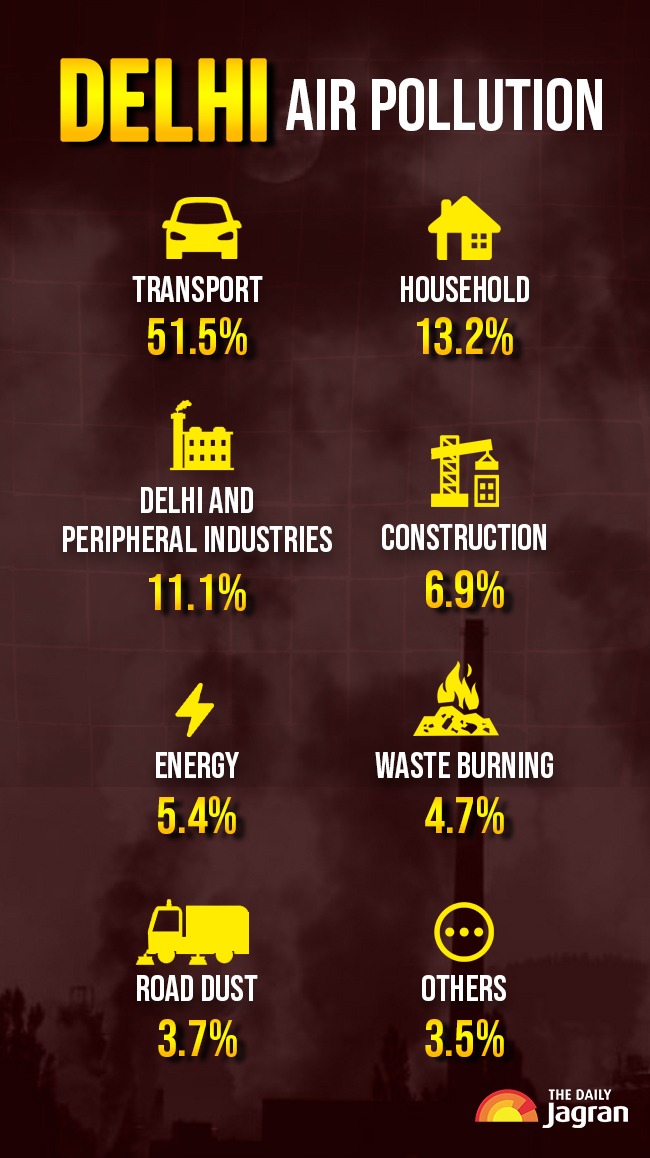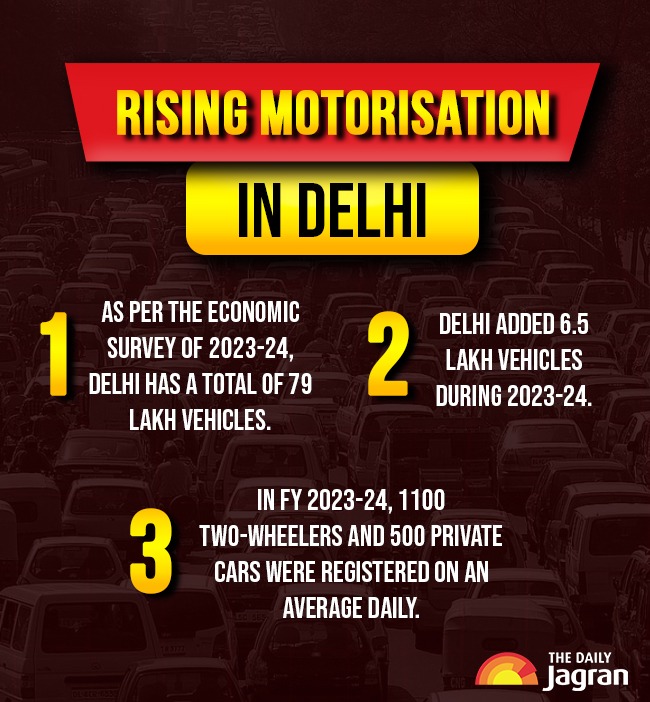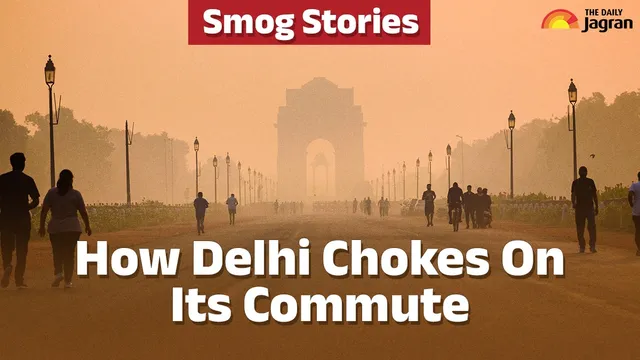- By Shubham Bajpai
- Mon, 13 Oct 2025 08:36 PM (IST)
- Source:JND
As winter is approaching, the biggest challenge that Delhi faces is to keep the air pollution under control and air breathable, a goal that the national capital fails to achieve each year.
The air quality starts depleting around October and attains a hazardous level after Diwali. There are several factors that contribute to poor air quality in Delhi. While some of them are based outside its territory, given its geography and economic positioning, others are the national capital's own factors.
Among Delhi's local pollution sources, the biggest contributor is vehicular pollution.
What is vehicular pollution, and what are its pollutants?
The vehicular pollution refers to the air pollution caused by the emissions from vehicles like buses, trucks, motorcycles and cars, among other motor-powered transportation.
In vehicular pollution, the pollutants that are emitted are:
-Carbon Monoxide (CO): The poisonous gas reduces the oxygen-carrying capacity of blood.
-Carbon Dioxide (CO₂): Contributes in global warming.
-Nitrogen Oxide (NOₓ): NOₓ causes respiratory problems and contributes to smog and acid rain.
-Particulate matter (PM2.5 and PM10): These are the tiny particles that can enter the lungs and cause diseases like asthma, bronchitis, etc.
-Sulfur dioxide (SO₂): Like NOₓ, it can also cause respiratory issues and acid rain.
-Hydrocarbons and Volatile Organic Compounds (VOCs): Some of them contribute to ground-level ozone, which forms the major component of the smog.

How big a contributor is vehicular pollution for Delhi?
The factors that cause depletion of the air quality in Delhi are several, but among the local sources, vehicular pollution's contribution to Delhi's PM 2.5 concentration is 51.5 per cent.
ALSO READ: Smog Stories: What Is AQI And How Is It Calculated By Monitoring Major Pollutants In Air? Explained
According to a report by the Centre of Science and Environment (CSE), the local contributors to PM 2.5 concentration made up 30.34 per cent between October 22 to November 3, last year.
Among that, 51.5 per cent is by vehicular pollution, followed by residential pollution at 13.2, and local and peripheral industrial pollution at 11.1 per cent.

Delhi's mobility crisis
The contribution of vehicular pollution highlights Delhi's mobility crisis. Economic Survey of 2023-24 stated that Delhi had a total stock of 79 lakh vehicles. In the year 2023-24 alone, the national capital added 6.5 lakh vehicles, according to the VAHAN database.
Although the annual addition in 2023-24 may sound big, it is still less than pre-pandemic level. Despite this, the winter average of PM2.5 concentration was the highest in 2023 at 189 µg/m3 in the last five years. However, the winter peak was lowest at 366, still much more than the annual average of 40 µg/m3 and 24-hour limit of 60 µg/m3.

Vehicular pollution contribution to NOₓ levels
The vehicular pollution is not limited to PM2.5 depleting concentration but also the nitrous oxide levels. According to the TERI ARAI, 2018 report, the transport has a dominant share of 81% in the NOx emissions amongst the sources within Delhi.
One of the biggest issues to consider in this direction is congestion. The CSE report confirmed that on holidays, when the travel speed was high, the NOx emission was low and on working days, the situation was vise versa.
ALSO READ: Smog Stories: Can Green Firecrackers Really Make Delhi’s Diwali Less Polluted?
What steps did government take?
Odd-Even scheme: The Delhi government, in January 2016, introduced the Odd-Even scheme, barring even numbered cars on odd dates and vice versa.
The policy's effect on controlling pollution is still debatable as the Central Pollution Control Board (CPCB) analyed that the reduction in PM 2.5 emission was not more than 3-4 per cent.
According to the Comptroller and Auditor General (CAG) report, there were 95 instances between January 2017 and March 2020 when the odd-even scheme under Graded Response Action Plan (GRAP) restrictions should have been enforced. However, the Department of Transport (DoT) implemented it only five times.
GRAP: The CPCB launched GRAP in 2017. According to the mechanics under which it is invoked, there are restrictions based on different levels of pollution.
| Stages | AQI | AQI Category | Restrictions and measures |
| Stage 1 | 201-300 | Moderate to Poor | - Mechanised road cleaning - Water sprinkling on roads - Control on garbage burning |
| Stage 2 | 301-400 | Very Poor | - Ban on diesel generators (except essential services) |
| Stage 3 | 401-450 | Severe | - Ban on construction and demolition activities (except essential projects) |
| tage 4 | 450+ | Hazardous | - Ban on entry of trucks (except essential goods) |
BS-VI Emission Norms: The government has enforced a nationwide BS-VI norm rom April 1, 2020, which is much stricter than BS-IV and reduces NOₓ, SO₂, and particulate matter emissions.
Ban on end-of-life vehicles: In 2015, the National Green Tribunal banned diesel vehicles over 10 years and petrol vehicles over 15 years. The decision was upheld by the Supreme Court in 2018.
(This article is part of the series 'Smog Stories'. To read more articles in the series, click here)

